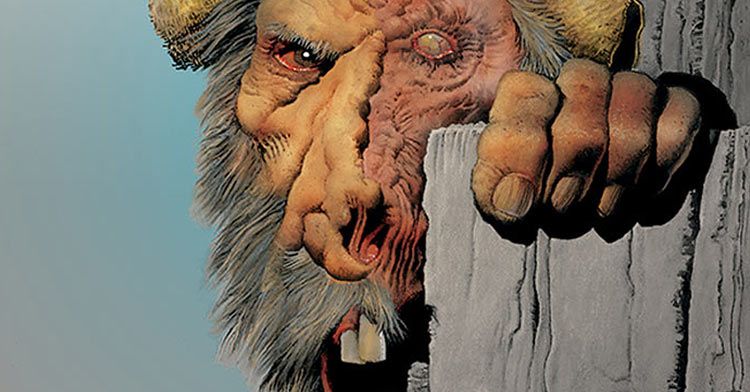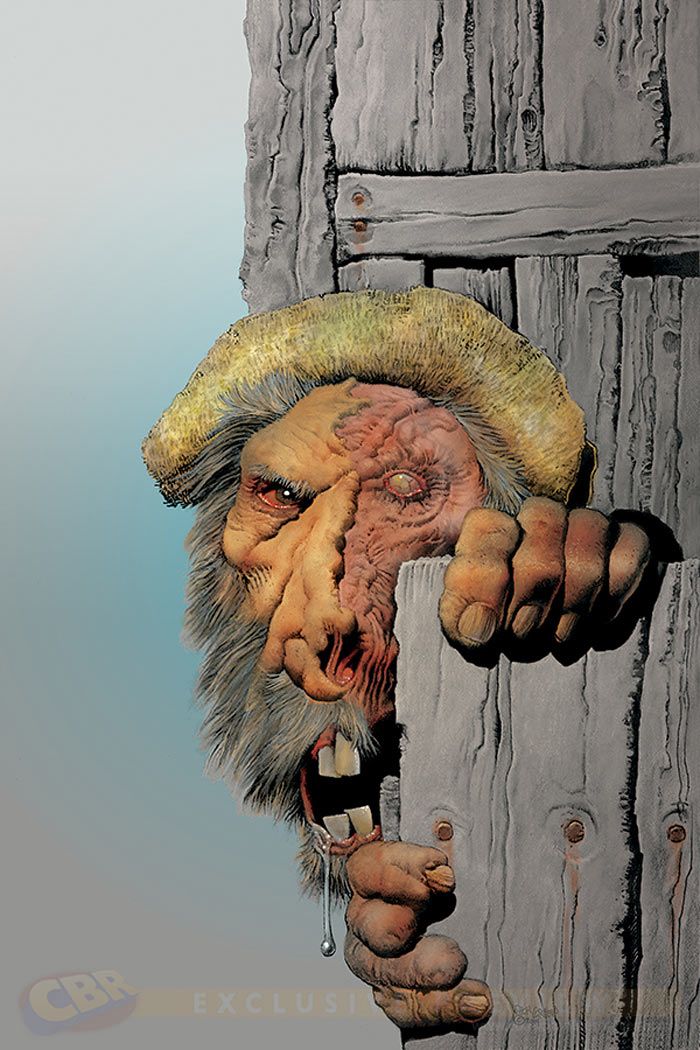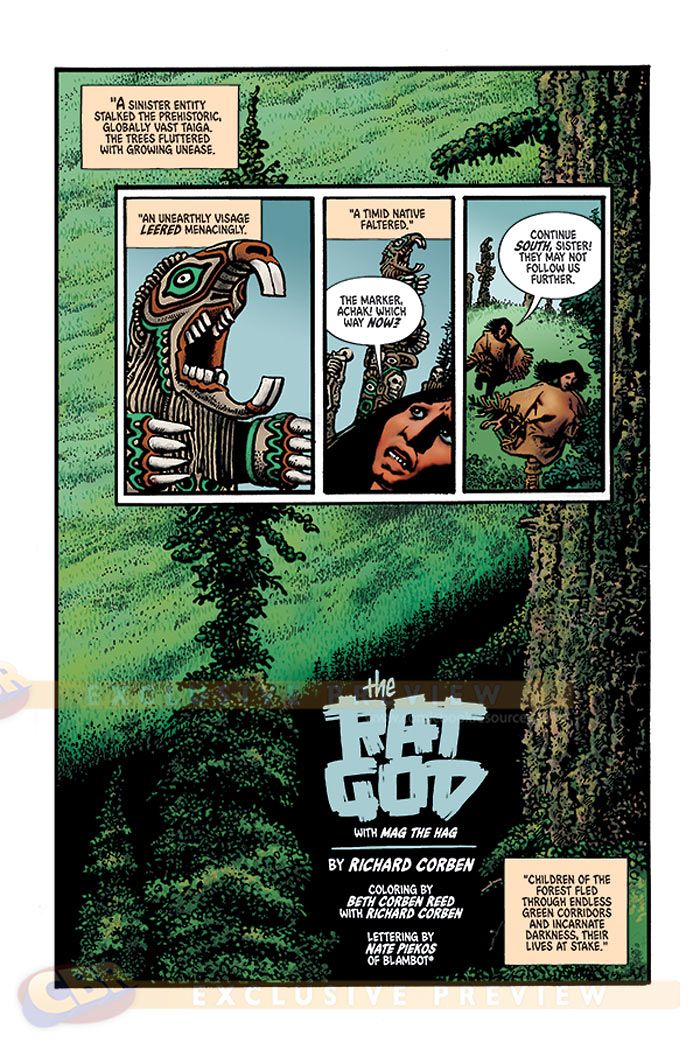Fans of modern horror comics are undoubtedly familiar with Richard Corben's work. Not only did the legendary comics illustrator's work show up in "Creepy" and "Eerie," his diverse body of work extends to coloring Will Eisner's "Spirit," a run on "Hellblazer" with Brian Azzarello and his "Haunt of Horror" miniseries in 2006 and 2008 -- and he's still got plenty of horror stories to tell. In February 2015, Corben's "Rat God" will debut through Dark Horse Comics., featuring lettering by "Usagi Yojimbo" creator Stan Sakai and coloring by Tom Luth.
RELATED: Corben Combines Poe's "Raven" with "Masque of the Red Death"
Over the course of five issues, Corben's story will combine Lovecraftian mythology with Native American lore for what looks to be a throughly frightening story. "Rat God" explores the forest surrounding Arkham as New England scholar Clark Elwood sets out on a quest to uncover the past of American Indian woman Kito Hontz -- which inevitably leads to uncovering the horrors surrounding the town of Arkham.
CBR News spoke with Corben about his approach to the new miniseries, including the challenge of combining Native American lore with H.P. Lovecraft's work, the research that went into completing the miniseries and the specific challenges that came from writing and drawing this particular tale.
CBR News: Richard, tell us a bit about "Rat God." What's the premise, and how does it relate to the lore of H.P. Lovecraft?
Richard Corben: When starting this project, I tried to pick out the elements of Lovecraft's that attract me. Of course there are many things that draw readers to his stories. For me, it is the well-developed but remote locations and, naturally, the monsters and how they are logically brought in. For "Rat God," I chose the remote North's wooded territories.
Who are the key players in "Rat God" and what kind of challenges do they face throughout the story?
First there's Clark Elwood, a tall New England scholar, who becomes intimate friends with a Miskatonic coed, Kito Hontz. She is an American Indian woman who has traveled far from her home in the North to attend the Miskatonic college. A strange cult from her home town, Lame Dog, takes her back to the Northern wilderness. Clark follows, and in his travels, he is challenged by not only the vast primeval forest but the primitive town and its surly inhabitants.
As "Rat God" incorporates both Lovecraft and Native American legends, which pieces of Native American mythology did you draw from?
Often when I'm developing a story, I don't know where it will take me. If I think there is an ancient community in the North woods, it follows that if it were really ancient, it would have to be somehow intertwined with Native American culture. A study of native tribes, their dress, life style and customs is not only mandatory as "back story," but actually led the scenario in different and unexpected directions.
You're obviously already familiar with Lovecraft, but what kind of research went into putting "Rat Gods" together? Were you already familiar with Native American lore?
I reread many of my favorites (in the hopes that some of his style might "rub off" into mine -- good luck with that!) S.T. Joshi's "Lovecraft, A Life" was very enlightening about many aspects of the writer. I also wanted to touch on the racism that colored much of his writing. This may seem alien to modern readers but it was actually common for that time period.
There are a large number of diverse groups of Native Americans called American Indians. I narrowed my researches down to several particular tribes of the American and Canadian Northwest, all with different costumes, languages, names and customs. In one passage, one of my characters "speaks" in Indian sign language when it was important to be quiet.
How did you approach melding two seemingly disparate artistic styles together in "Rat God"? Traditional Lovecraft illustrations have an admittedly different tone from those from Native American legend.
In all honesty, I have never tried to imitate specific art styles to use with some continuity in a long story like this. But there are some motifs that are common to most mythologies and religions, such as animals who might be worshiped as gods, or at least powerful spirits. It is inevitable that I would use such elements in my story, even if it is on a subconscious level.
What kind of surprises are in store for fans of your previous work in "Rat God"? Did you approach this project differently than some of your past projects?
"Rat God" is different for me in that I tried to write it as a whole story, not a series of short episodes. Much of my longer work in the past has been written "hit and miss." That's because these earlier pieces were never conceived as parts of a longer story. (This doesn't count all the long stories written by other professional writers.) Say, my editor might have said to me (but didn't really), "Will you stop your endless complaining about the stories you are given to do, and do one yourself that you like!" So I found myself in the position of "put up or shut up!" That is what I did. It is very hard work; I knew it would be.
What is the biggest challenge -- both in writing and art -- that you think you face with "Rat God"?
Aside from the art production, which is both a love and the hardest of challenges, the writing, as I suggested before, was the biggest, most difficult for me. This is compounded by the problem that I can't just stop writing when I do the art. I keep getting more ideas about the story as I draw the panels. In some cases, if I think the new idea is better than the one that went before, I will either rework a page or several pages, or in a worst-case scenario, I might add some pages, or just redraw them. I guess this has to do with thorough preplanning and discipline. And it is not over yet. I'm still, writing, drawing, rewriting, redrawing and more. Sometimes it seems I will never finish a story. Yipes!
Richard Corben's "Rat God" begins February 2015.



